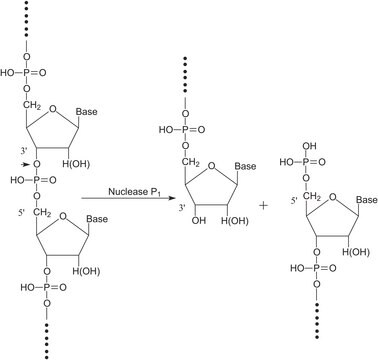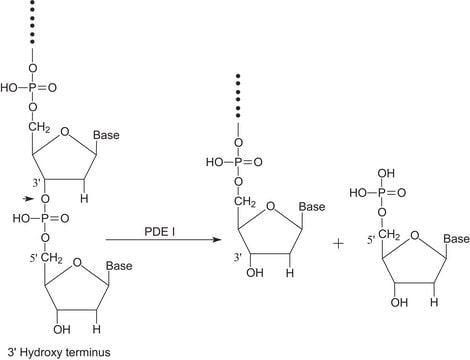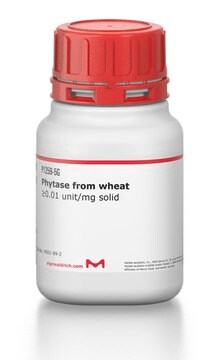P5931
Phosphatase, Alkaline from Escherichia coli
lyophilized powder, 30-60 units/mg protein (in glycine buffer)
Sinónimos:
Orthophosphoric-monoester phosphohydrolase (alkaline optimum)
Iniciar sesiónpara Ver la Fijación de precios por contrato y de la organización
About This Item
Productos recomendados
form
lyophilized powder
Quality Level
specific activity
30-60 units/mg protein (in glycine buffer)
composition
Protein, ~50% biuret
storage temp.
−20°C
¿Está buscando productos similares? Visita Guía de comparación de productos
Categorías relacionadas
General description
Alkaline phosphatase (ALP) of E.coli is a member of an enzyme group that possesses intragenic complementation.
Application
Alkaline phosphatase is used for conjugation to antibodies and other proteins for ELISA, Western blotting, and histochemical detection. It may be used for protein labeling when high sensitivity is required. Product P5931 has been used during immunoblots to treat cell membranes prior to Tau1 incubation.
The enzyme from Sigma has been used to develop a synthetic nanopore membrane. This membrane mimics protein channels that are regulated by phosphorylation/dephosphorylation and uses an aligned array of carbon nanotubes (CNTs) impregnated in a polystyrene matrix.
Biochem/physiol Actions
Alkaline phosphatase, from Escherichia coli, is a dimeric, non-glycosylated protein which mainly reside in the periplasmic space. Three known isoforms exist. The enzyme requires zinc, and is activated by magnesium. E. coli akaline phosphatase has a broad specificity for phosphate esters.
The enzyme is a phosphohydrolase having an optimal pH of 10 in vitro. The actual optimum pH varies depending on the nature and concentration of the substrate, the type of buffer, the phosphate acceptor, and to some extent the nature of the isoenzymes. It catalyzes the hydrolysis of phosphate monoesters such as p-nitrophenyl phosphate, phenyl phosphate, phenolphthalein phosphate, α-glycerol phosphate, β-glycerol phosphate, 2-phosphorylglycerate, triosephosphate, glucose-6-phosphate, glucose 1-phosphate, fructose 1-phosphate, fructose 6-phosphate, adenosine 5-phosphate adenosine 3-phosphate, phosphoenolpyruvate, and β-nicotinamide adenine dinucleotide phosphate. The activity is inhibited by 1,10-phenanthroline monohydrate, diethylenetriaminepentaacetic acid, ethylene glycol-bis(2-aminoethylether)-N,N,N′,N′-tetraacetic acid, and ethylenediaminetetraacetic acid disodium salt dihydrate.
Unit Definition
One unit will hydrolyze 1.0 μmole of p-nitrophenyl phosphate per min at pH 10.4 at 37 °C.
Physical form
Lyophilized powder containing Tris buffer salts, MgSO4, and ZnSO4
Preparation Note
Chromatographically purified
inhibitor
Referencia del producto
Descripción
Precios
signalword
Danger
hcodes
pcodes
Hazard Classifications
Resp. Sens. 1
Storage Class
11 - Combustible Solids
wgk_germany
WGK 1
flash_point_f
Not applicable
flash_point_c
Not applicable
ppe
Eyeshields, Gloves, type N95 (US)
Elija entre una de las versiones más recientes:
¿Ya tiene este producto?
Encuentre la documentación para los productos que ha comprado recientemente en la Biblioteca de documentos.
Los clientes también vieron
1.Reid, T., and Wilson
E. coli Alkaline Phosphatase,The Enzymes, 3rd Ed. Vol. 4, 4, 373-373 (1971)
Characterization of Heterodimeric Alkaline Phosphatases from Escherichia coli: An Investigation of Intragenic Complementation
Hehir MJ, et al.
Journal of molecular biology, 304(4), 645-656 (2000)
A Takeda et al.
The Journal of biological chemistry, 275(8), 5395-5399 (2000-02-22)
Increased expression of heme oxygenase-1 (HO-1) is a common feature in a number of neurodegenerative diseases. Interestingly, the spatial distribution of HO-1 expression in diseased brain is essentially identical to that of pathological expression of tau. In this study, we
Alkaline phosphatase from Thermotoga neapolitana.
A Savchenko et al.
Methods in enzymology, 331, 298-305 (2001-03-27)
R A Anderson et al.
Proceedings of the National Academy of Sciences of the United States of America, 72(1), 394-397 (1975-01-01)
To facilitate the study of individual metal binding sites of polymeric metalloproteins, conversion of exchange-labile Co(II) in E. coli alkaline phosphatase (EC 3.1.3.1) to exchange-inert Co(III) was examined. Oxidation of Co(II) alkaline phosphatase with hydrogen peroxide results in a single
Nuestro equipo de científicos tiene experiencia en todas las áreas de investigación: Ciencias de la vida, Ciencia de los materiales, Síntesis química, Cromatografía, Analítica y muchas otras.
Póngase en contacto con el Servicio técnico






